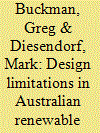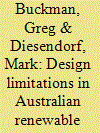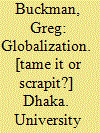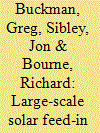|
|
|
Sort Order |
|
|
|
Items / Page
|
|
|
|
|
|
|
| Srl | Item |
| 1 |
ID:
096646


|
|
|
|
|
| Publication |
2010.
|
| Summary/Abstract |
Renewable electricity is pivotal to the medium and long-term reduction of Australia's greenhouse gas (GHG) emissions, if deep cuts in them are eventually implemented. This paper examines the effectiveness of the principal existing policies that could potentially promote the expansion of renewable electricity (RElec) in Australia: the expanded Renewable Energy Target (RET); the proposed emissions trading scheme (ETS); and the state and territory-based feed-in tariffs. We find the effectiveness of RET is severely eroded by the inclusion of solar and heat pump hot water systems; by the inclusion of 'phantom' tradable certificates; and by high electricity consumption growth. We also find that the ETS will not produce a high enough carbon price to assist most RElec technologies before 2020; and that most of the feed-in tariffs exclude large-scale RElec and will give little assistance to small-scale RElec because they are mostly net tariffs. Unless there is a major revision of its RElec policy mechanisms, Australia will fail to reach its renewable electricity target and in particular will fail to build up its solar generation capacity which could be a major source of future deep cuts in the country's electricity generation emissions.
|
|
|
|
|
|
|
|
|
|
|
|
|
|
|
|
| 2 |
ID:
097480


|
|
|
|
|
| Publication |
2010.
|
| Summary/Abstract |
Renewable electricity is pivotal to the medium and long-term reduction of Australia's greenhouse gas (GHG) emissions, if deep cuts in them are eventually implemented. This paper examines the effectiveness of the principal existing policies that could potentially promote the expansion of renewable electricity (RElec) in Australia: the expanded Renewable Energy Target (RET); the proposed emissions trading scheme (ETS); and the state and territory-based feed-in tariffs. We find the effectiveness of RET is severely eroded by the inclusion of solar and heat pump hot water systems; by the inclusion of 'phantom' tradable certificates; and by high electricity consumption growth. We also find that the ETS will not produce a high enough carbon price to assist most RElec technologies before 2020; and that most of the feed-in tariffs exclude large-scale RElec and will give little assistance to small-scale RElec because they are mostly net tariffs. Unless there is a major revision of its RElec policy mechanisms, Australia will fail to reach its renewable electricity target and in particular will fail to build up its solar generation capacity which could be a major source of future deep cuts in the country's electricity generation emissions.
|
|
|
|
|
|
|
|
|
|
|
|
|
|
|
|
| 3 |
ID:
107491


|
|
|
|
|
| Publication |
2011.
|
| Summary/Abstract |
Renewable Portfolio Standards (RPSs) are renewable electricity (RES-E) subsidy mechanisms in which governments mandate how much RES-E should be generated and markets determine the cost of the subsidy needed to generate the RES-E. Two modifications of the RPS that can help support high-cost types of RES-E are banding, where governments mandate higher multiples of RPS tradable certificates for high-cost types of RES-E, and carve-outs, where governments prescribe parts of a RPS target that can be met only by a particular type, or types, of RES-E.
This paper analyses the design and generation performance of banding, as used in the UK, with some reference to Italy; and carve-outs, as used in the USA. To date, there is insufficient experience of either device to reach firm conclusions about their generation effectiveness. However, there is early, tentative evidence that banding is successful at supporting high-cost types of RES-E in the UK. Carve-outs are not being fully exploited in US states that use a RPS mechanism, and Italy is using banding in a fairly insignificant way. Though both devices have different design strengths and weaknesses, and either could be adapted to specific RPS markets, banding is probably the better device for supporting high-cost RES-E.
|
|
|
|
|
|
|
|
|
|
|
|
|
|
|
|
| 4 |
ID:
058111


|
|
|
|
|
| Publication |
Dhaka, University Press, 2004.
|
| Description |
229p.
|
| Standard Number |
184277381X
|
|
|
|
|
|
|
|
|
|
|
|
Copies: C:1/I:0,R:0,Q:0
Circulation
| Accession# | Call# | Current Location | Status | Policy | Location |
| 049002 | 337/BUC 049002 | Main | On Shelf | General | |
|
|
|
|
| 5 |
ID:
132593


|
|
|
|
|
| Publication |
2014.
|
| Summary/Abstract |
Feed-in tariffs (FiTs) offer renewable energy developers significant investor certainty but sometimes at the cost of being misaligned with generation costs. Reverse FiT auctions, where the FiT rights for a predetermined capacity are auctioned, can overcome this problem but can be plagued by non-delivery risks, particularly of competitively priced proposals. In 2012 and 2013 the Australian Capital Territory (ACT) Government in Australia conducted a FiT reverse auction for 40 MW of large-scale solar generating capacity, the first such auction undertaken in the country. The auction was highly competitive in relation to price and demonstrating low delivery risks. Proposal capital costs, particularly engineering, procurement and construction costs, as well as internal rates of return, were lower than expected. The auction process revealed limited land availability for large-scale solar developments in the ACT as well as a significant perceived sovereign risk issue. The auction process was designed to mitigate non-delivery risk by requiring proposals to be pre-qualified on the basis of delivery risk, before considering FiT pricing. The scheme is likely to be used by the ACT Government to support further large-scale renewable energy development as part of its greenhouse gas reduction strategy which is underpinned by a 90-per cent-by-2020 renewable energy target.
|
|
|
|
|
|
|
|
|
|
|
|
|
|
|
|
|
|
|
|
|